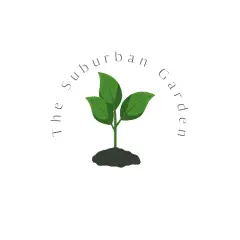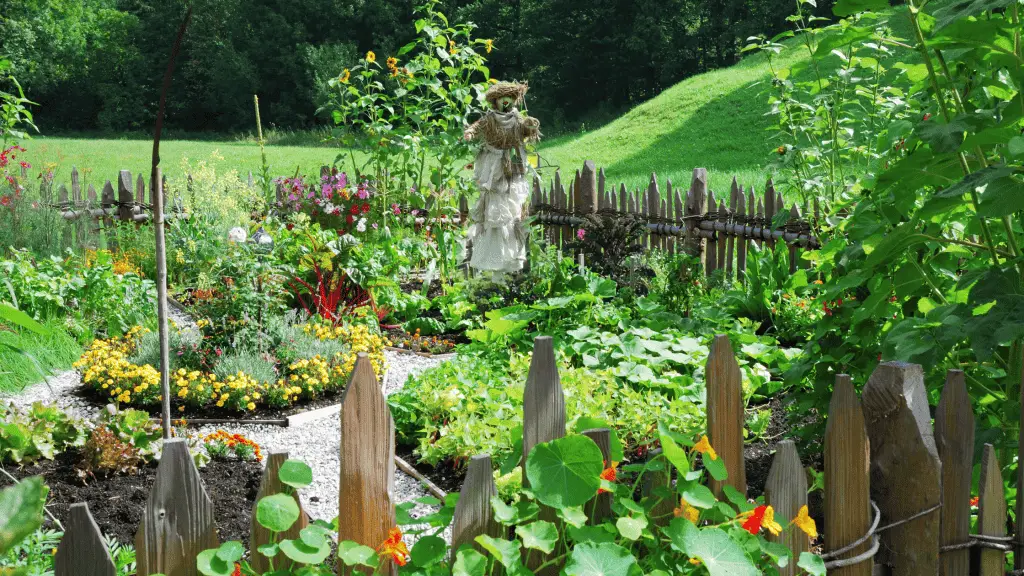Do you want your garden to be amazing, but it’s just not quite there yet? Sometimes, no matter how hard we try, our gardens need a little boost to reach their full potential. It can be frustrating when you’ve put in a lot of effort, but your garden still isn’t as great as you hoped.
But guess what? There’s a simple trick that could make all the difference. Imagine your garden filled not just with veggies but also with beautiful flowers of all colors. Think about the sweet smell and the busy bees buzzing around. Sounds nice, right? Well, it’s totally possible!
All you need to do is add some flowers to your garden! Yep, it’s that easy. Flowers don’t just look pretty; they actually help your veggies grow better too. In this blog post, we’ll show you exactly how to do it and why it works.
Why Mix Flowers with Vegetables?
Adding annual flowers like marigolds, sunflowers, and zinnias to your vegetable crops can revolutionize gardening. This approach not only adds vibrant color to your vegetable garden but also has tons of environmental benefits. Attracting beneficial insects is one of the biggest advantages.
Flowers like sweet alyssum and lavender are magnets for ladybugs and lacewings, who in turn manage pest populations. That means a seriously reduced need for chemical pesticides. But flowers aren’t just about pest control.
Adding in flowers like calendula and borage enhances soil health by building biodiversity within your garden ecosystem. They accomplish this through companion planting schemes that promote a balanced, natural growth environment.
Finally, adding flowers to your vegetable garden simply makes it more aesthetically appealing, transforming it into a visually stunning display of both blooms and greenery.
Top 10 Flowers to Plant
Marigolds: Known for their vibrant colors, marigolds deter pests and enhance soil health. They thrive in well-drained soil and only need occasional fertilization.
Sweet Alyssum: This flower attracts beneficial insects, aiding in organic pest control. It prefers well-drained, fertile soil and tolerates varying conditions.
- Beautiful – Full color seed packet of Sweet Alyssum, Royal Carpet flowers (Lobularia maritima). This annual dwarf variety is an AAS winner. Royal Carpet has delicate purple flowers that are fragrantly sweet. Low to the ground at 4-6″ tall. Useful for edging borders, filling in flower beds, and in pollinator gardens. Minimum of 400 mg per packet (about 1100 seeds).
Sunflowers: Standing tall, sunflowers bring beauty and improve pollination. Make sure to give them plenty of room, though. They require spacing of 12 to 24 inches and relish in well-drained soil.
- 520 Mammoth Sunflower Seeds to Plant: Enjoy a hassle-free gardening experience with Mammoth Sunflowers. These seeds are crafted for fast, easy growth, ensuring a thriving garden with minimal effort.
- Vibrant Colors for Seasonal Beauty: Elevate your outdoor space with Mammoth Sunflowers, delivering stunning and vibrant colors during their peak bloom, typically in late summer or early fall. Your garden will be a visual delight throughout the growing season.
Cosmos: Cosmos flourish in poorer soils, producing abundant blooms. They attract beneficial insects and improve biodiversity within the garden. They also make a great cut flower.
- QUALITY – All seeds packaged by Seed Needs are intended for the current and the following growing seasons. All seeds are stored in a temperature controlled facility that is free of significant amounts of moisture.
- QUANTITY – Seed packets by Seed Needs offer generous quantities. You can share with friends and family, or save your extra seeds until the next season, if properly stored.
Nasturtiums: Offering peppery blooms, nasturtiums serve as companion plants. They prefer poorer soils and help in soil health management. These edible flowers can also be used as a trap crop to draw pests away from your other plants.
- QUALITY – All seeds packaged by Seed Needs are intended for the current and the following growing seasons. All seeds are stored in a temperature controlled facility that is free of significant amounts of moisture.
- QUANTITY – Seed packets by Seed Needs offer generous quantities. You can share with friends and family, or save your extra seeds until the next season, if properly stored.
Zinnias: With their bright flowers, zinnias attract pollinators and enhance garden aesthetics and also make excellent cut flowers. They’re relatively easy to grow and thrive in rich, well-drained soil.
- Beautiful – Full color seed packets of California Giant Zinnia (Zinnia elegans) flowers. This variety produces beautiful red, orange, yellow, lavender, maroon, violet, and white blossoms. Enjoy outside in the garden and indoors as cut flowers. Minimum of 1g per packet (about 175 seeds).
- Productive – Zinnia germinates in 7-10 days when soil temp is 75-78°F. Plant 1/4” deep and space 18” apart in an area with full sunlight. This variety will grow 3-4’ feet tall with a huge 5-6” blooms. Flowers will mature in 60-80 days, plant in USDA zones 3-9.
Calendula: It’s well known for its medicinal properties, but calendula also improves soil health. This flower thrives in varied soil conditions and will contribute to the overall health of your garden.
- GORGEOUS – Who doesn’t love a bright, happy flower bed of calendula flowers? Also makes great cut flowers.
- ANNUAL – The beautiful calendula flower plants are annuals and will need to be grown each year in your flower garden.
Borage: Borage’s blue flowers aren’t just pretty; they attract pollinators and are very beneficial in companion planting. This plant prefers organic-rich soil, so make sure you amend your planting space with compost.
- Quality Borage seeds packaged by Seed Needs. Intended for the current and the following growing season. Packets are 3.25″ wide by 4.50″ tall and come with a full colored illustration on the front side, as well as detailed sowing instructions on the reverse.
- Both Borage seed packets will contain 100 seeds each, for a combined total of 200 seeds.
Lavender: Lavender not only is beautiful and smells nice; it also draws pollinators to your garden. It can be harvested to make tea and works well in dried flower arrangements. It demands well-drained, slightly alkaline soil for optimal growth so keep this in mind when planting.
- QUALITY – All seeds packaged by Seed Needs are intended for the current and the following growing seasons. All seeds are stored in a temperature controlled facility that is free of significant amounts of moisture.
- QUANTITY – Seed packets by Seed Needs offer generous quantities. You can share with friends and family, or save your extra seeds until the next season, if properly stored.
Basil: Basil makes a great companion plant for tomatoes! This culinary herb not only enhances vegetable flavors, basil also attracts beneficial insects.
- Beautiful – Large color packet of the popular culinary herb Genovese Basil (Ocimum Basilicum), a wonderful gift for the gourmet cook and gardener. Can easily be grown indoors in your kitchen or outdoors in the garden. There is actually enough seed to do both. Minimum of 400mg (about 400 seeds).
- Productive – Basil genovese germinates in 5-10 days when soil temps are 70-80°F. Plant 1/4” deep and space 9-12” apart in an area with full sun. This variety will grow 2-3’ tall with a spread of 10-16”. This variety will mature in 60-90 days, but you can begin harvesting as soon as your plant has 3 or 4 sets of leaves. Plant in USDA Zones 10-12.
The Benefits of Flowers in Your Vegetable Garden
Attracting Beneficial Insects
If organic gardening is your end goal, incorporating annual flowers like marigolds, sweet alyssum, and sunflowers into the vegetable garden can be a huge help. These vibrant additions attract beneficial insects like ladybugs and lacewings, which are ideal for preying on pests like aphids.
The introduction of these flowers does not only reduce the reliance on chemical pest control but also promotes a balanced ecosystem. By integrating zinnias, calendula, borage, lavender, and basil, you foster an environment where predatory insects manage pest populations for you, ensuring your vegetable garden remains healthy and productive.
Enhancing Pollination
In addition to drawing beneficial insects, flowers play a pivotal role in pollination. Flower attract a diverse array of pollinators, including bees, butterflies, and hummingbirds, creating a bustling hub of activity in your garden. This leads to improved pollination and increased yield of your vegetable garden.
Improving Soil Health
Not only can adding flowers around your vegetables draw beneficial insects and improve pollination, it also offers profound benefits for the health of your soil. Marigolds, calendula, and borage, when planted in your vegetable garden, have been shown to enhance soil structure and contribute valuable nutrients. These blooms don’t just look pretty; they work hard to prepare and maintain a nurturing environment for your vegetables to thrive in.
Garden Design and Aesthetics
Mixing flowers with vegetables goes beyond the practical benefits of biodiversity, beneficial insects, and soil health. It touches upon something inherently aesthetic and pleasing to the eye. Gardens have always been spaces of beauty, and by adding annual flowers like marigolds, sweet alyssum, and zinnias, you create a canvas of color. These splashes of hues make your vegetable garden not just a place of sustenance but also a visual delight.
Frequently Asked Questions
Can I use perennial flowers in my vegetable garden, or should I stick to annuals?
While annuals like marigolds and sunflowers provide instant color and benefits for a single season, perennials can offer lasting structure and support to your garden’s ecosystem. Including both types diversifies your garden’s appeal and functionality.
What flowers are best for deterring pests?
Marigolds stand out for their ability to repel undesired insects. Nasturtiums and lavender can also serve as effective pest deterrents, adding beauty while safeguarding your veggies.
Which flowers should I plant to attract pollinators?
Sweet alyssum, cosmos, and zinnias are excellent at attracting bees and butterflies, crucial for pollination. Their vibrant blossoms ensure a bustling garden.
How do flowers impact soil health?
Flowers like calendula and borage enhance soil structure and fertility by attracting beneficial insects that contribute to nutrient cycling. Their roots can also help to break up compact soil, improving aeration and water infiltration.
Are there any aesthetic benefits to mixing flowers with vegetables?
Beyond practical advantages, integrating flowers introduces color, texture, and variety, elevating your garden from a mere plot of edibles to a vibrant tapestry of blooms and produce.
Final Thoughts
Incorporating flowers into your vegetable garden is not only aesthetically pleasing but also provides numerous benefits that can enhance both plant health and productivity. Flowers attract beneficial insects that help with pollination and pest control, creating a more balanced and sustainable garden ecosystem. Additionally, certain flowers can improve soil health and even deter pests naturally.
Whether you opt for vibrant marigolds to ward off nematodes or sweet alyssum to lure beneficial predators, adding flowers to your vegetable garden is a practical step toward a more fruitful and enjoyable gardening experience. Remember, the key is diversity—a colorful mix of flowers can lead to a healthier garden and a more bountiful harvest. So, embrace the beauty and utility of flowers to make your vegetable garden a thriving, vibrant space.











